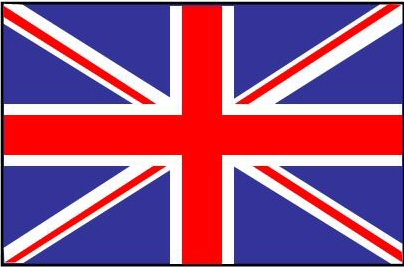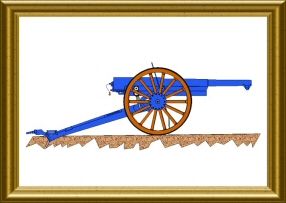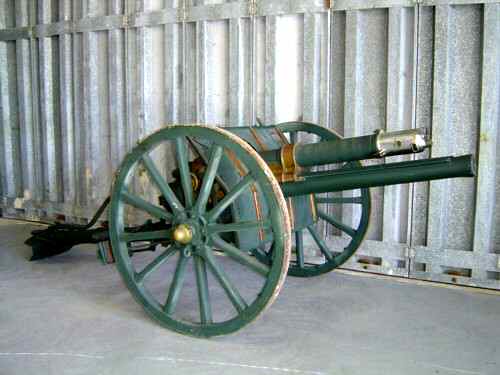|
|
|
|
|
|
|
 Great Britain
|
QF 18-Pdr field gun Mk. I & Mk. II |
 Light artillery
|
|
|
Contributor :
Ian Grimwood
Anthony Owen
|
Location :
Australia
Sydney, NSW
North Head Artillery School
Coordinates :
Lat : -33.81720 / Long : 151.29720
|
General comments on this surviving gun :
After closure of North Head the collection was moved to storage at Bandiana awaiting setup of display at Puckapunyal VIC.
Australian Army Artillery Museum Collects, preserves and exhibits the history of Artillery in Australia.General and Research Enquiries: peter.armstrong1@defence.gov.au
The Artillery Collection is currently in storage pending the development of a new facility at Puckapunyal Military Area, near Seymour in Victoria. A small display of the Museum's collection can be viewed at the Australian Army Tank Museum.
http://www.army.gov.au/our-history/army-museum-network/corps-museums. 'Unfortunately due to heightened security restrictions and the museum's location within an active army base, it is currently not open to the public'
Identical items in the same location :
1
Items covered by this file :
1
|
|

|
|
|
This gun is equipped with the hydro-pneumatic recuperator, giving it a tordedo-like shape.
|
|
|
|
|
Historic and technical information
|
|
Denomination :
QF 18-Pdr field gun
|
Origin :
 (
Royal Arsenal)
(
Royal Arsenal)
 (
Vickers )
(
Vickers )
 (
Armstrong )
(
Armstrong )
|
|
Historic context :
Second gun born from a British Army technical specification inspired from 15-pdr Erhardt fieldguns bought in 1900, the 18 pounder gun planned for a Field Artillery usage was the fruit of a collaboration between Armstrong (tube), Vickers (craddle), et Royal Ordnance Factories (carriage).
It was almost abandonned in the early 1900's and replaced by the more manoeuvrable Horse Artillery 13 pounder, from the same generation. Only the inpired intervention from the Prime Minister Balfour allowed its adoption in 1904 and its deployment in the Army from 1906.
The first fights of 1914 proved this decision was wise, the 'QF 18-pounder gun' being more efficient than the 13-Pdr (particularly in power - its shell being also heavier than tbe ones of the French and German fieldguns), in both its Mk I and Mk II tube versions (wire wound then jacketted). Equipped with a screw breech mechanism, its main weaknesses were the low range (5166 m) caused by the Mk I and Mk Ii carriage tubular trail that limited the elevation angle to 16 degrees and the fragile hydro-mechanic recuperating system.
The range issue could only be solved (7132 m) by digging in the tail end into the ground, before it was finally fixed thanks to the substitution of the pole trail with a polygonal one on the Mk IV on Mk III carriage version (that was indeed a brand new gun that only participated in the late battles in small quantities).The Mk I carriage hydro-spring recuperator weakness was fixed during the war by the addition of a oil reservoir box at the front end of the cylinder, then by its substitution with a new hydro-pneumatic system on the Mk II carriage (that gave to the break front end a characteristic torpedo-like shape).
1135 such guns were produced before WW1, and 8393 other ones during the war. They were distributed to all the British Empire armies (Canada, South Africa, Australia and New Zealand). USA manufactured anoyher 851 guns for the United Kingdom before 1917, then modified the design so that this gun could fire French 75mm shells. These guns were named 'Gun, 75mm, M1917 (British)' and used by the American Expeditionary Forces (AEF) in Europe.
|
Technical data :
- Complete description : Ordnance Quick Fire 18 pounder field gun Mark I and II on Mk I and Mk II carriages
- Design year : 1904
- Calibre : 83.80 mm (3.3 in)
- Weight in firing position : 1285 kg
- Weight for transportation :
- Tube length in calibres : 29.40
- Grooves : 0
- Projectile weight : 8.4 kg
- Initial speed : 492 m/s
- Fire rate : 4 shots / minute
- Range : 5166 m (7132 m when burying the tail end) for the Mk I and Mk II carriages; 8700 m for the Mk III carriage;
- Elevation range : -5 to +16 degrees (Mk I and Mk II carriage)
- Direction range : 8 degrees total range
|
Sources
|
-
Allied Artillery of World War One Ian V. Hogg Crowood 1998
-
British Artillery 1914-19, Field Army Artillery Dale Clarke Osprey Publishing 2004
|
|